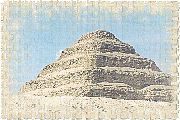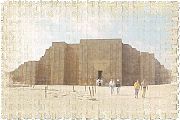|
The
complex of Djoser at Saqqara is one of the oldest known structures
to have been constructed completely with natural stone. It
was built at the beginning of the third dynasty, around 2625
BC, and was intended as a funerary complex for king Djoser.

View of the Djoser Step-Pyramid
|
A
limestone wall of 10.5 metres high and enclosing an area of
1.5 hectares surrounds the complex. A recessed panelling motif
is used to decorate the wall. This motif is known as the serekh
or "palace fašade" motif and was mainly used in a royal context.
Protruding bastions are reminiscent of towers in strongholds
or fortresses. The complex is entered through a narrow door
in the southeast part of the enclosure wall.
|
 |

Entrance to the Djoser Complex |
The
entrance already reveals an important feature of the architecture
of Djoser's complex: each part of the structure was inspired
on existing, mudbrick and wooden structures. The decoration
of the entrance hall's ceiling is an imitation of rounded
wooden beams. Immediately after the entrance the stone is
cut to resemble an open wooden door.
The
entrance hall itself is a long narrow passage flanked by high
pillars. The fact that the pillars are connected to the outer
walls of the entrance hall indicates that they do not have
a supporting function. The pillars themselves are meant to
resemble several stems of papyrus plants tied together. The
entrance hall opens into a vestibule with four pillars that
again do not have a supporting function.
The
exit of the vestibule is marked by a stone imitation of an
open door. This door opens onto a large open court, the so-called
"South Court".
|
 |
The
walls around this court are dressed with fine limestone, parts
of which are still visible today. The recessed panelling motif
on this wall is similar to that on the outside of the enclosure
wall, but on the inside of the complex, there are no bastions.

One of the pillars situated in
the entrance |
Against
the south part of the enclosure wall and immediately facing
the Entrance Hall, a wall, forming an angular projection into
the court, was decorated with recessed panels, topped by small
drums (suggesting rolled reed-mats), and a frieze of uraei.
On its north face, a small blocked entrance can be found.
The interior of this building is completely filled with rubble,
a feature that is prominent in the complex. It is obvious
that the building was not intended for daily use by mere mortals.
This building has been interpreted as a copy of a chapel.
(Jacques
Kinnaer)
|